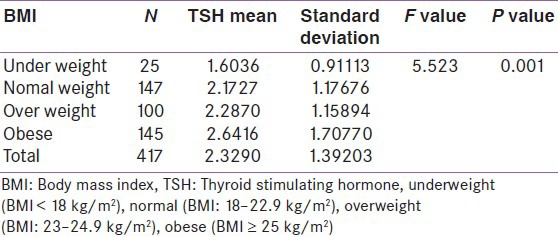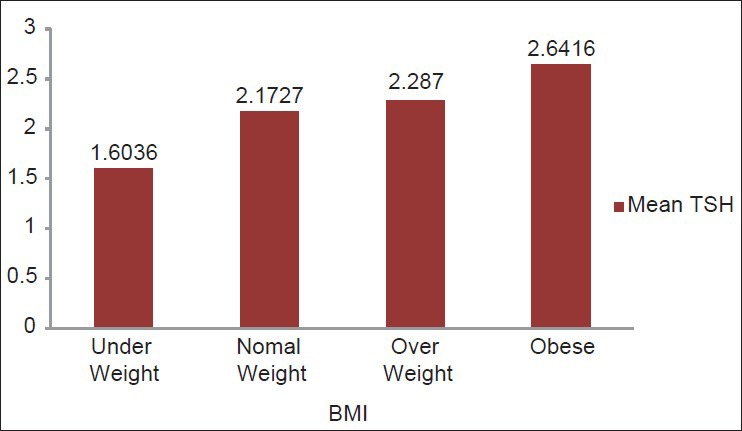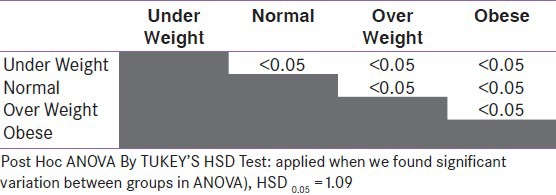Abstract
Objective:
To investigate any possible relationship between serum thyroid stimulating hormone (TSH) with body mass index (BMI) in healthy adults.
Materials and Methods:
A total of 417 subjects aged 18-60 years who volunteered to get screened for thyroid illness with serum TSH have been enrolled from November 2012 to July 2013. Patients were divided into four groups based on BMI value: Underweight (BMI <18 kg/m2), normal (BMI: 18-22.9 kg/m2), overweight (BMI: 23-24.9 kg/m2), and obese (BMI ≥25 kg/m2).
Result:
In our study we found a significant variation (P < 0.001) in TSH with increasing BMI. As the BMI increased, mean TSH in the BMI range also increased. The individuals with higher BMI had higher TSH and this trend continued from underweight to Obese. The mean TSH of underweight group was 1.6036 mIU/L, normal weight group 2.1727 mIU/L, overweight group 2.2870 mIU/L and obese group 2.6416 mIU/L.
Conclusion:
In this study we found a significant relationship between serum TSH and BMI and mean TSH increased as BMI increased. Further large scale data from the population is required to confirm our findings.
Keywords: Body mass index, overweight, obesity, subclinical hypothyroidism, thyroid stimulating hormone
INTRODUCTION
Obesity is increasingly being identified as a major epidemic today raising worldwide health concerns. Relationship between thyroid profile and body mass measures including body mass index (BMI) has previously been studied but not well understood. Most recent studies focusing on this relationship have conflicting results. Even small changes in TSH levels can have an effect on BMI profile.[1] There exists a significant positive association between TSH and BMI in euthyroid subjects.[2,3] Other studies show no evidence for an association between thyroid status within the normal range and BMI.[4] The question that arises is how compelling it is to look at serum TSH value of an individual in light of his BMI and what scientific evidence we have in our population to support our clinical decision making in this context. Through this study we aim to define any relationship that might exist between serum TSH and BMI in healthy adult subjects with TSH range between 0.4mIU/L and 10mIU/L.
Aims and objectives
To investigate any possible relationship between serum TSH and BMI in healthy adults.
MATERIALS AND METHODS
Population
A total of 417 subjects aged 18-60 years who volunteered to get screened for thyroid illness with serum TSH have been enrolled from November 2012 to July 2013. Patients have been divided into groups: Underweight (BMI < 18 kg/m2), normal (BMI: 18-22.9 kg/m2), overweight (BMI: 23-24.9 kg/m2), obese (BMI ≥ 25 kg/m2).[5] The serum TSH values have been measured with chemiluminescence method. All samples were assayed in the same laboratory.
Inclusion criteria
Healthy adults (age group 18-60 year), staff and students of institutions comprising Peoples University Bhopal. All the volunteers wishing to participate in our study from November 2012 to July 2013 have been enrolled.
Volunteers without any self-reported thyroid illness never treated for any thyroidal illness, with TSH value between 0.4mIU/L and 10mIU/L have been taken for the purpose of studying relationship between TSH and BMI.
Exclusion criteria
Subjects with any past history of thyroid illness or treatment taken for thyroid illness have been excluded. Volunteers with TSH <0.4mIU/L or >10mIU/L have been excluded.
Any patient with chronic liver disease (CLD), chronic renal disease (CRD), pregnancy or taking any drug altering serum TSH levels (octreotide, somatostatin, opiates, dopamine, glucocorticoids, growth hormone, L-dopa, bromocriptine, pimozide, phentolamine, thioridazine, methysergide, cyproheptadine, iodine, dopamine antagonists, amiodarone) have been excluded.[6]
Thyroid function study
Levels of serum TSH have been done by chemiluminescence method. All samples were assayed in the same laboratory.
Anthropometrical measurements
Weight (kg) and height (m) have been measured while the subjects were barefoot and wearing light clothes. BMI was calculated as body weight (kg) divided by height squared (m2).
Study design
Population-based cross-sectional study. All the volunteers from staff and students of Peoples University willing to participate in our study have been enrolled. The results are drawn using one-way analysis of variance (ANOVA).
RESULTS
A total of 417 subjects aged 18-60 years who volunteered to get screened for thyroid illness with serum TSH have been enrolled from November 2012 to July 2013. Our study is still undergoing and further enrollment of volunteers is on. Till now there are 161 males and 256 females enrolled in our study. The population has been divided into different BMI groups. Mean TSH of every BMI group has been shown in Table 1. The mean TSH of underweight group was 1.6036 mIU/L, normal weight group 2.1727 mIU/L, overweight group 2.2870 mIU/L and obese group 2.6416 mIU/L [Figure 1]. In Post Hoc ANOVA By TUKEY'S HSD Test applied when we found a significant variation between groups in ANOVA, the pair wise comparision between groups was also found significant (HSD 0.05 =1.09) [Table 2].
Table 1.
Distribution of TSH according to BMI

Figure 1.

Distribution of TSH according to BMI. BMI = Body mass index, TSH = Thyroid stimulating hormone, underweight (BMI <18 kg/ m2), normal (BMI: 18-22.9 kg/m2), overweight (BMI: 23-24.9 kg/m2), and obese (BMI ≥ 25 kg/m2)
Table 2.
Pair wise Comparison (Tukeys HSD)

The mean TSH shows an increasing trend with increasing BMI. In our study we found a significant relationship (p<0.001) between TSH and increasing BMI.
DISCUSSION
We studied the relationship between different BMI groups and serum TSH and as the BMI increased mean value of serum TSH also increased. The plausibility of association between TSH and BMI could be due to TSH directly stimulating preadipocyte differentiation and resulting in adipogenesis.[7,8] Leptin is another explanation of the association.[8] Smoking has been considered confounder and variously studied. Smokers were found to have lower TSH and BMI. A study in Norway found association only in nonsmokers,[2] another study found TSH and BMI correlation as strong in current smokers as never smokers.[3] Age is a confounder as well. A gradual increase in serum TSH has been found with age in men and women. The effects of excess bodyweight on thyroid could differ between lower grades of overweight and morbid obesity.[9] The need arises to ascertain if slightly high TSH can cause obesity, and furthermore if the reverse is true i.e. high leptin levels in obesity, can increase thyroid dysfunction or autoimmunity causing higher risk of subclinical or overt hypothyroidism.[9] Nevertheless, the results from large studies and longitudinal data gives positive association2 between serum TSH and BMI.
Limitation
The lack of data on thyroid peroxidase (TPO) antibodies is limitation of study. Smoking as a confounder in Indian population also needs to be assessed.
CONCLUSION
In our study we found a significant relationship in serum TSH with BMI and mean TSH increased as BMI increased. Further large scale multicentric and longitudinal studies are required to further enlighten us on the question and its clinical implications.
Footnotes
Source of Support: Nil
Conflict of Interest: None declared
REFERENCES
- 1.Knudsen N, Laurberg P, Rasmussen LB, Bulow I, Perrild H, Ovesen L, et al. Small differences in thyroid function may be important for body mass index and the occurrence of obesity in the population. J Clin Endocrinol Metab. 2005;90:4019–24. doi: 10.1210/jc.2004-2225. [DOI] [PubMed] [Google Scholar]
- 2.Nyrnes A, Jorde R, Sundsfjord J. Serum TSH is positively associated with BMI. Int J Obesity. 2006;30:100–5. doi: 10.1038/sj.ijo.0803112. [DOI] [PubMed] [Google Scholar]
- 3.Asvold BO, Bjøro T, Vatten LJ. Association of serum TSH with high body mass differs between smokers and never-smokers. J Clin Endocrinol Metab. 2009;94:5023–7. doi: 10.1210/jc.2009-1180. [DOI] [PubMed] [Google Scholar]
- 4.Manji N, Boelaert K, Sheppard MC, Holder RL, Gough SC, Franklyn JA. Lack of association between serum TSH or free T4 and body mass index in euthyroid subjects. Clin Endocrinol. 2006;64:125–8. doi: 10.1111/j.1365-2265.2006.02433.x. [DOI] [PubMed] [Google Scholar]
- 5.Misra A, Chowbey P, Makkar BM, Vikram NK, Wasir JS, Chadha D, et al. Consensus statement for diagnosis of obesity, abdominal obesity and the metabolic syndrome for Asian indians and recommendations for physical activity, medical and surgical management. J Assoc Phys India. 2009;57:163–70. [PubMed] [Google Scholar]
- 6.Surks MI, Sievert R. Drugs and thyroid function. N Engl J Med. 1995;333:1688–94. doi: 10.1056/NEJM199512213332507. [DOI] [PubMed] [Google Scholar]
- 7.Valyasevi RW, Harteneck DA, Dutton CM, Bahn RS. Stimulation of adipogenesis, peroxisome proliferator-activated receptor gamma (PPARgamma), and thyrotropin receptor by PPARgamma agonist in human orbital preadipocyte fibroblasts. J Clin Endocrinol Metab. 2002;87:2352–8. doi: 10.1210/jcem.87.5.8472. [DOI] [PubMed] [Google Scholar]
- 8.Feldt-Rasmussen U. Thyroid and leptin. Thyroid. 2007;17:413–9. doi: 10.1089/thy.2007.0032. [DOI] [PubMed] [Google Scholar]
- 9.Rotondi M, Leporati P, La Manna A, Pirali B, Mondello T, Fonte R, et al. Raised serum TSH levels in patients with morbid obesity: Is it enough to diagnose subclinical hypothyroidism? Eur J Endocrinol. 2009;160:403–8. doi: 10.1530/EJE-08-0734. [DOI] [PubMed] [Google Scholar]


